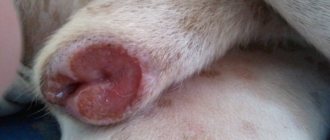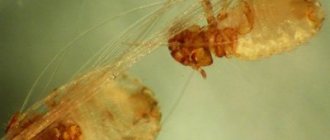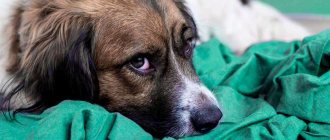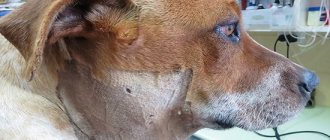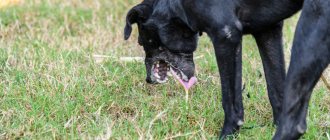Some owners have doubts and cannot say for sure whether flux occurs in dogs, or whether this disease is characteristic only of humans. The answer is simple - it happens. The main cause of oral diseases is insufficient hygiene. In the absence of competent care and the presence of other provoking factors, pets are no less vulnerable than their owners.
One of the possible complications of flux is meningitis, that is, inflammation of the meninges. For this reason, a sick animal must be examined at a veterinary clinic immediately after the first alarming symptoms appear.
What is periostitis, or gumboil in a dog?
The disease is an infectious inflammation of the periosteum - the tissue surrounding the jaw. Due to infection, serous exudate accumulates in the upper part of the diseased tooth, gradually transforming into pus. Over time, it penetrates the bone tissue and settles in the periosteum.
In addition to meningitis, the lack of timely treatment of the pathology is fraught with jaw deformation and tooth loss, the formation of phlegmon or abscess, as well as blood poisoning.
Swelling in the cheek area, causes
The most common dental causes of cheek swelling are:
- advanced caries;
- complication of pulpitis;
- complication of gingivitis;
- periostitis, periodontitis and other diseases of teeth and gums.
If you suspect flux, call: 8 (495) 558-88-77
Flux is inflammation of tissues of various origins, for example, periostitis, an inflammatory process in the periodontal gap - periodontium. Such inflammation can occur in acute and chronic forms; the chronic form can periodically enter an exacerbation phase and then subside again.
By origin, periostitis is as follows:
- infectious;
- non-infectious;
- spicy;
- chronic;
The main role in the development of flux of infectious origin belongs to microorganisms, as well as their toxins. Microbes penetrate into the periodontium through the root canal, periodontal pocket, as well as through the blood or lymph flow.
Most often, flux is caused by an infection that enters through the root canal and is a consequence of acute diffuse and chronic gangrenous pulpitis, as well as pulp necrosis.
Microorganisms and their toxins, penetrating into periodontal tissue, cause dangerous acute inflammation
Non-infectious periostitis/periodontitis (fluxes) can develop as a result of trauma (blow, bruise, periodontal trauma after pulp extirpation, sharp, uncomfortable biting on a tooth; cracking nuts, gnawing bones) or chronic microtrauma (smoking pipe, brass band instruments, biting threads, pressing on the tooth with a pencil, pen, etc.); also as a result of the influence of medications - the ingress of potent substances into the periodontium during the expansion of root canals (trilon B, aqua regia), their sterilization (formalin, silver nitrate, etc.) and in the ingestion of arsenic paste.
Types of pathology
Based on the nature and duration of the course, 4 types of pathology are distinguished. These include:
- Serous
. The mildest form that does not require long-term treatment. Occurs due to mechanical injuries (bruises in a fight or unsuccessful jumps).
- Purulent
. A severe form of the disease, observed at a later stage of development along with the appearance of purulent exudate.
- Diffuse
. The most dangerous form, developing against the background of advanced purulent inflammation. Over time, some of the pus enters the bloodstream, causing sepsis.
- Chronic
. It occurs less frequently than other forms and is characterized by a sluggish course and mild symptoms. It is observed in animals with weak immunity.
Before seeking help, try to analyze the possible causes of the inflammatory process. This information will help your veterinarian during diagnosis.
Forms of the disease
The intensity and painfulness of the process depends not only on the stage, but also on its form. In some cases, in addition to the gums, the periosteum is also affected, which leads to residual deformation of the jaw and even sepsis.
Flux in dogs is divided into four stages:
- Serous
. Compared to the others, it is considered the easiest form. Rarely causes high fever, and swelling is not very pronounced. - Acute purulent
. With it, a noticeable whitish or reddish abscess always forms in the gum area. The course is complicated; the animal often refuses not only food, but also water. - Diffuse
. Causes the most severe symptoms and most often leads to fatal consequences. In this case, the purulent focus is no longer concentrated in one place, but spreads throughout the soft tissues and along the periosteum. This stage requires immediate treatment, as it can provoke sepsis. - Chronic
. Very rare. It affects animals with weakened immune systems or other chronic pathologies. The swelling periodically subsides, but becomes hard. Lymph nodes located nearby become enlarged.
Purulent contents can be located on the upper or lower jaw. Veterinarians believe that localization from below is less dangerous. If flux appears on the upper jaw, then not only the periosteum, but also brain tissue may be involved in the inflammatory process. The consequence of this development of events is sometimes meningitis.
Causes of tumor formation
The main reason for the appearance of gumboil in dogs is insufficient oral hygiene. Due to the lack of regular brushing of teeth, food particles accumulate and harden on the enamel. The resulting tartar expands the space between the gums and teeth. Pieces of food stuck in this gap rot and create pathogenic microflora that attract bacteria.
In addition to insufficient hyena, owners should pay attention to other provoking factors:
- complications of other oral pathologies (stomatitis, pulpitis, gingivitis);
- gum injuries from hard and sharp objects;
- hypothermia, colds and stress that weaken the immune system;
- lack of solid food in the diet, which prevents the natural removal of plaque from the enamel (abuse of soft canned food);
- secondary infection after removal of a diseased tooth;
- inflammation of the gum pocket - a favorite place for most harmful microorganisms.
As a result of a protracted inflammatory process, unilateral or bilateral swelling occurs on the animal’s face. The affected side increases in size, frightening the owners with its appearance.
Symptoms and signs
The first sign of a problem is that the dog wants to eat, but cannot.
- The animal walks in circles around the food, whines, tries to grab the food with its lips, but cannot chew and throws it away.
- The same thing happens with drinking, however, if the water is at the optimal temperature, then the pet can take a few sips.
- The inability to eat is explained by severe pain, and the dog’s entire jaw hurts.
- During sleep, he suddenly jumps up, behaves restlessly, and whines.
- A more detailed examination reveals loose teeth.
- After drinking, you can see blood in a container of water.
- The animal has a fetid odor from the oral cavity and continuous profuse salivation.
- If the upper part of the jaw is affected, nosebleeds may be recorded.
During the period of illness, the dog is unable to eat normally.
Serous flux
In serous cases, there is slight swelling of the jaw and the periosteum is swollen. With this type of flow, the animal does not experience severe discomfort and can behave with virtually no changes.
With serous flux, the dog's jaw swells slightly.
Purulent flux
Purulent flux is characterized by the formation of pustular wounds on the affected gum. The body temperature rises, the entire oral cavity is swollen and painful, bright red. A pungent smell of rotting from the mouth, profuse salivation.
Purulent flux is characterized by increased body temperature.
Diffuse flux
During a diffuse course, the animal feels extremely ill. Aggression gives way to apathy, the dog lies down and whines pitifully. Constantly rubs his face with his paws. The body temperature is significantly increased, yellow saliva, possibly mixed with blood, continuously flows from the mouth.
With diffuse flux, the dog becomes apathetic.
Symptoms at different stages of the disease
At the initial stage, behavioral changes appear. The pet often comes to the feeder, but due to pain, eats only on one side or spits out the food while chewing. A similar situation occurs with water, since the pain covers the entire jaw.
The serous form is accompanied by swelling of the jaw and swelling of the periosteum. At this stage, the pain is tolerable, so sleep disturbances and increased anxiety are not observed. Snoring may occur.
With the appearance of pus, sores appear on the gums. The entire oral cavity becomes very swollen and red. The cheek on the affected side swells. There is profuse salivation and increased body temperature.
When transitioning to the diffuse form, the animal constantly fiddles with its muzzle, whines and sleeps poorly. The mouth has an unpleasant rotten odor and often bleeds blood, which can be found in bowls of food and water. Teeth become loose and begin to fall out. When the infection enters the nasopharynx, the symptoms are complemented by nosebleeds.
How do symptoms appear?
Symptoms may not appear at first, but the dog will experience pain immediately. As a result, her behavior will change.
Flux symptoms:
- pain;
- mild swelling on the gum;
- salivation;
- bleeding or discharge from gums or gums;
- unpleasant odor from the mouth;
- nausea;
- fever;
- ear pain; food falling out on the floor while eating;
- refusal of dry food.
Your pet may rub its face against various objects to scratch the swelling or reduce discomfort from it.
How is the treatment carried out?
The veterinarian decides what to do, taking into account the type of gumboil in the dog. Depending on the condition of the four-legged patient, the resulting inflammation is eliminated in 2 ways: conservative or surgical.
Antibiotic therapy
In most cases, a bacterial infection is to blame for the inflammatory process. To prevent its further development, broad-spectrum antibiotics are used (Amoxicillin, Tsiprovet, Ceftriaxone). Antibiotic therapy is prescribed at the initial stage of pathology or after surgery.
No less important is symptomatic therapy, including:
- painkillers that relieve pain;
- anti-inflammatory, stopping foci of inflammation;
- immunomodulators that stimulate the immune response.
If the abscess is fully formed, then taking medication alone will not be enough. In this case, the abscess is opened, washing and rinsing the resulting cavity with antiseptics.
Washing and rinsing
In addition to opening the abscess, it may be necessary to remove tartar. In both cases, mandatory sanitation of the oral cavity is carried out. For washing, use tinctures of oak bark, chamomile and calendula. These plants have a disinfecting effect and prevent the development of secondary infections.
Surgical intervention
A more radical solution to the problem is tooth extraction. The operation is performed in advanced forms of the disease using general anesthesia. The intervention is carried out in the clinic, and after it the patient is sent home for further treatment.
Is it possible to treat flux in dogs at home?
At the initial stage, excluding the absence of an abscess, the animal is given an anesthetic and anti-inflammatory. After this, the oral cavity is washed with a herbal decoction. To prepare it, you need to pour 1 liter of boiling water into 180 g of a dried mixture of St. John's wort, sage and oak bark. After 2 hours of infusion, the mixture is cooled, filtered and used to treat the affected area.
If periostitis occurs for the first time and there are no medications in the house to relieve inflammation and pain, be sure to consult a veterinarian. Selecting medications on your own is not safe.
Regardless of the condition, after all the manipulations have been carried out, the pet will have to be taken to the veterinary clinic. Full treatment at home can only be carried out after diagnosis, so limit your actions to first aid. Otherwise, you may not notice concomitant diseases and encounter new inflammation - in a more advanced form.
Treatment of periostitis with physical factors
The complex approach to the treatment of periostitis is complemented by the use of therapeutic physical factors:
- ultra-high-frequency therapy (an electromagnetic field, or UHF, acts as a therapeutic factor in inflammatory processes);
- magnetic applicators (magnetotherapeutic treatment of inflammatory processes);
- medicinal electrophoresis (using an electric current of low voltage and low strength, a medicinal substance is introduced into the body as an additional therapeutic factor);
- helium-neon laser rays (have anti-inflammatory, bactericidal, regenerative effects).
Animal care
During treatment, provide your four-legged pet with complete rest. Temporarily limit his activity by refusing training and participation in sports disciplines.
To avoid bone problems, review your current diet. Basic food products must contain sufficient amounts of phosphorus, calcium and vitamin D. If this is not possible, then the listed vitamins and minerals can be obtained from special complexes.
Until recovery, all food should be soft and warm. The absence of hard pieces and high temperatures will prevent injury to the already affected oral cavity.
Clean water and food bowls more thoroughly than before - using mild detergents and plenty of warm water. The animal's feeding area must be spotlessly clean so that there is no chance of secondary infection.
Dog food for gingivitis
To quickly and successfully treat gingivitis in dogs, as well as prevent relapses, a special diet is prescribed for 2-3 months. The animal needs to be switched to high-protein soft food (categories: super-premium/holistic).
They do not damage the mucous membranes of the oral cavity, and most importantly, they contain all the minerals and vitamins necessary for the restoration of the body. After each meal, it is necessary to rinse the dog's mouth with a chlorhexidine solution.
If for certain reasons you cannot buy specialized food, you will temporarily have to switch to natural food. In this case, the pet’s diet will include pureed vegetables and meat:
- rabbit,
- veal,
- chicken,
- turkey.
Several times a week you can give your dog low-fat cottage cheese, kefir and natural yogurt. They are useful for strengthening bone tissue. To avoid vitamin A deficiency, once a week you can give your dog boiled fish, previously deboned.
Prevention measures
For the health of your four-legged friend, do not forget about preventive recommendations. Oral problems can be easily avoided by:
- Regular teeth cleaning
. Buy toothpaste with meat flavor to reduce mistrust of this unpleasant procedure. Ordinary gauze soaked in a soda solution is also suitable for cleaning.
- Proper combination of hard and soft foods
. Abuse of the first type is fraught with increased bleeding of the gums, and the second - the formation of tartar, loosening of the gums and subsequent tooth loss. Special chewing toys sold in pet stores are also suitable for cleaning plaque.
- Annual examinations at the veterinary clinic
. For dwarf breeds, the frequency of visits should be doubled, as they suffer more than others from dental diseases.
If tartar forms, contact your veterinarian immediately. Plaque can be eliminated using ultrasonic cleaning, preventing the development of complications.
Periostitis is a dangerous disease fraught with many complications. Despite this, it is quite easy to treat at the initial stage. To detect pathology, you need to carefully monitor your pet’s behavior, trying not to lose sight of even the most minor changes.
The article is for informational purposes only. Contact your veterinarian!
Do you like the article? 205
Types of gingivitis
By type of manifestation:
Spicy. Its main feature is its vivid clinical picture. All symptoms of gingivitis (redness, swelling, bleeding) appear quickly. The pet's condition is rapidly deteriorating.
Chronic. Symptoms develop gradually. Improvements are observed periodically (for example, swelling of the gums goes away) and relapses. Chronic gingivitis is more dangerous because it is difficult to diagnose in the early stages.
By degree of distribution:
Localized . Inflammation of the gums and other accompanying symptoms appear pointwise (locally) and cover not the entire oral cavity, but a certain area. In this case, the pet tries to chew food in the area where there is no gingivitis.
Generalized . The inflammatory process covers all soft tissues. This makes it possible to quickly diagnose gingivitis, but at the same time significantly complicates its treatment, since the symptoms are extensive.
The nature:
Catarrhal (serous ). This is the most common type of gingivitis and develops under the influence of external factors (for example, bacteria or allergens). Usually localized throughout the oral cavity.
Hypertrophic . Occurs due to internal factors (for example, hormonal imbalances or diseases of the gastrointestinal tract). In this case, hypertrophic gingivitis is localized on the incisors, molars and canines.


